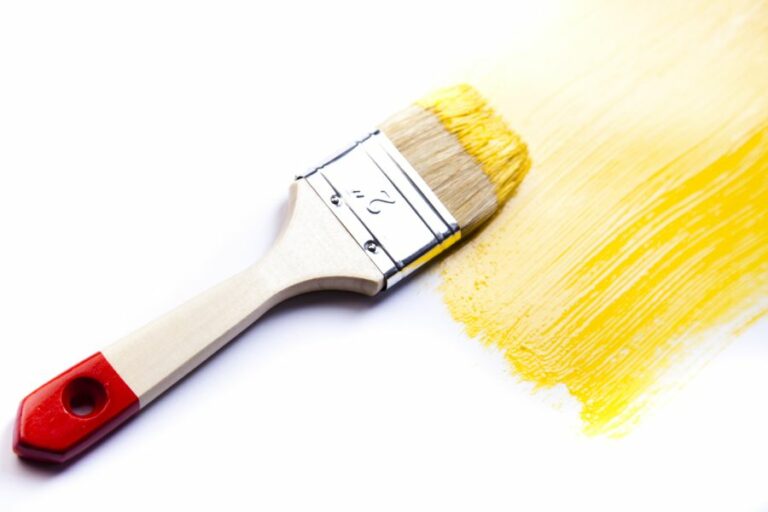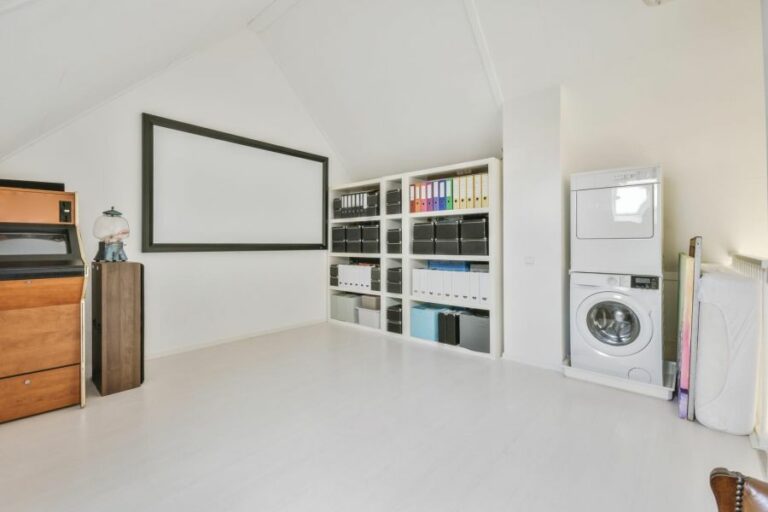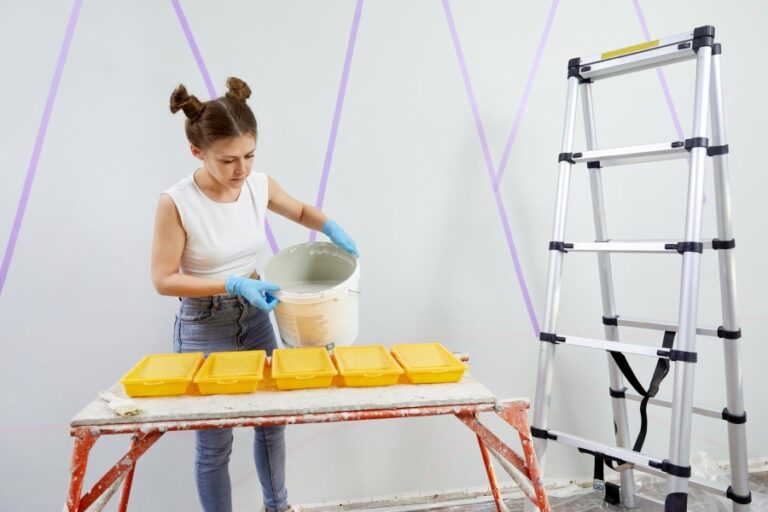Green Interior Paint Products, 25 Things You Should Know
You’re not alone if you’ve considered a fresh coat of paint to liven up your living space. With the growing awareness of environmental issues, many homeowners are turning to green interior paint products for a beautiful and eco-friendly makeover. Might you be wondering: can eco-friendly paint products provide the same quality and finish that consumers have come to expect?
Green interior paint products:
Green interior paint products are environmentally friendly, using eco-conscious ingredients and manufacturing processes, reducing toxins and waste. These paints contain lower amounts of volatile organic compounds (VOCs), improving indoor air quality and minimizing health risks. Some top green paint brands include Benjamin Moore Natura, Farrow & Ball Eco-Friendly Paints, AFM SafeCoat Zero VOC Paint, BioShield Clay and Solvent-Free Wall Paints, and Sherwin-Williams Harmony.

Are you considering a fresh paint job for your interiors? Let’s dive into the world of green interior paint products that beautify your home and promote a healthier environment. Read on for more eco-friendly tips, suggestions, and the latest trends in green interior paint solutions.
Contents
- 1 Eco-friendly Interior Paint Options
- 2 Top Green Paint Choices for Kitchen Walls
- 3 Best Green Paint Color Selection
- 3.1 • Understanding Undertones: The Foundation for the Perfect Green
- 3.2 • Light or Dark: Assessing the Desired Intensity of Your Green Paint
- 3.3 • Evaluate the Surroundings: Complementing Your Green Paint
- 3.4 • Test Before You Commit: Sampling Green Paint Colors
- 3.5 • Conclusion: Embrace the Versatility of Green Paint
- 4 Green: A Suitable Color for Home Interiors?
- 5 Most Soothing Green Hue: Discover the Calm
Eco-friendly Interior Paint Options
• Why Choose Green Interior Paint Products?
Environmentally friendly and sustainable paint products, commonly called “green” paint products, prioritize the health of humans and the planet. These products use eco-conscious ingredients and manufacturing processes that produce fewer toxins and produce less waste.
Ultimately, this results in a cleaner indoor air quality and lower environmental impact.
Paints typically contain Volatile Organic Compounds (VOCs), which consist of toxic chemicals that can cause both short- and long-term health effects. Green interior paint products contain lower amounts of VOCs, or none at all, which greatly reduces the risk of respiratory problems, headaches, and other health issues.
Choosing green interior paint products can be especially beneficial for people with allergies, asthma, or chemical sensitivities.
• Understanding Green Certification Labels
When shopping for green interior paint products, you may encounter several certification labels that can aid in the decision-making process. Some notable certifications include:
- Green Seal: This non-profit organization evaluates products based on various environmental criteria, including VOC levels, recycled content, and biodegradability. Green Seal-certified paints must meet a set of rigorous standards. Green Seal’s website provides a full list of certified products.
- GREENGUARD: This certification verifies that a paint product has low VOC emissions and minimal impact on indoor air quality. GREENGUARD-certified paints are tested in a controlled environment to ensure that they comply with set criteria. UL’s GREENGUARD Certification page offers more information on this certification.
- LEED (Leadership in Energy and Environmental Design): This rating system, developed by the U.S. Green Building Council, covers a broad range of sustainable building practices, including the use of green interior paint products. A paint product that contributes to LEED points can be deemed environmentally friendly.
• Top Green Interior Paint Products & Brands
Here are some well-known and trusted green interior paint brands and products available in the market:
1. Benjamin Moore Natura
Benjamin Moore’s Natura line is a waterborne paint with zero VOCs and zero emissions, making it suitable for those looking to minimize their environmental impact. Natura has received certification from Green Seal and Cradle-to-Cradle.
With its quick-drying formula and vast color selection, Natura could be a top choice for any eco-conscious homeowner.
2. Farrow & Ball Eco-Friendly Paints
Farrow & Ball offers a luxurious line of green interior paint products with water-based formulas that are environmentally friendly and user-friendly. All Farrow & Ball paints have low VOC levels and strive to minimize any impact on the environment.
Their outstanding color range and high-quality finish make these paints an excellent choice for anyone seeking an eco-friendly option without sacrificing style.
3. AFM SafeCoat Zero VOC Paint
AFM SafeCoat offers interior paint products with low-to-zero VOC levels. Their paint range is designed specifically to minimize the risk for those with allergies, asthma, or chemical sensitivities.
SafeCoat’s paints are not only eco-conscious, but they also resist mold and mildew, contributing to healthier indoor air quality.
4. BioShield Clay and Solvent-Free Wall Paints
BioShield offers a range of natural and eco-friendly paint products, including clay paint and solvent-free wall paint. Their paints are derived from natural materials, such as clay, minerals, and plant-based ingredients.
With low VOCs and no harmful chemicals, BioShield paints to ensure a healthier, more sustainable option for anyone looking to ‘go green.’
5. Sherwin-Williams Harmony
Sherwin-Williams’ Harmony line offers environmentally-friendly paint products that contain low VOC levels and have the GREENGUARD Gold certification. The harmony paint line has also been specifically formulated to reduce lingering paint odors.
Their extensive color selections, paired with their commitment to environmental responsibility, make Harmony a popular choice for homeowners and professionals alike.
• Tips for Using Green Interior Paint Products
- Ventilation: Always ensure proper ventilation when using any paint product, but especially green interior paint products. Open windows, use fans and take breaks to minimize exposure.
- Paint Disposal: Properly dispose of leftover paint by donating it, giving it away, or recycling it where available. Visit Earth911 for more information on local recycling programs.
- Eco-Friendly Painting Tools: Invest in eco-friendly painting tools, such as those made with recycled materials or natural fibers. These help reduce waste and contribute to overall sustainability.
In conclusion, green interior paint products provide a healthier and more environmentally conscious alternative to traditional paint products. By choosing green paints, consumers can reduce their ecological footprint while enhancing their indoor air quality.
With numerous brands and products on the market, finding the perfect eco-friendly paint has never been easier.
Top Green Paint Choices for Kitchen Walls
A fresh coat of paint can completely transform a space, and the kitchen is no exception. With so many shades of green to choose from, it can be overwhelming to decide on the perfect hue for the walls.
• Top Green Paint Picks for a Fresh and Invigorating Kitchen
– Sage Green
Sage green is a timeless and versatile choice for your kitchen walls. This soft, muted color brings a sense of calm to your space, making it an ideal backdrop for both modern and traditional kitchen styles. A popular option for sage green paint is Farrow & Ball’s Ball Green.
– Willow Green
For a slightly more vibrant take on earthy green hues, willow green is an excellent choice. It offers a fresh and welcoming atmosphere without being overly bright or bold. Its subtle pop of color pairs well with natural materials such as wood, stone, and plants.
One recommendation for willow green paint is Sherwin-Williams’ Haven.
– Pistachio Green
Pistachio green paints infuse your kitchen with a lighthearted and playful vibe. This delightful hue combines the warmth of yellow with the freshness of green, creating a unique and energizing atmosphere. A lovely option for pistachio green paint is Dulux’s Soft Pistachio.
– Olive Green
Olive green walls add depth and sophistication to your kitchen while maintaining a warm and inviting feel. This versatile shade works beautifully in both traditional and modern settings, complementing a wide range of colors and materials. One must-try olive green paint is Benjamin Moore’s Tate Olive.
– Emerald Green
For a bold and luxurious statement, emerald green paints are a true showstopper. This rich and regal color brings an opulent and energizing feel to the kitchen, making it an unforgettable gathering space. A popular emerald green paint option is Behr’s Elegant Jewel.
• Tips for Selecting the Perfect Green Paint
– Assess the Viewing Conditions
Before choosing a paint color, consider the natural and artificial lighting in your kitchen. The green hue may appear darker or brighter depending on the lighting conditions, so it’s essential to view paint samples in the actual space before making a decision.
By selecting the right hue and taking note of the lighting conditions in your kitchen, you’ll craft the perfect space for cooking, dining, and entertaining. Happy painting!
Paint Brand | Paint Color | Color Code |
|---|---|---|
Benjamin Moore | Garden Path | 0642 |
Sherwin Williams | Oyster Bay | SW6206 |
Farrow & Ball | Calke Green | No.34 |
Behr | Back to Nature | S340-4 |
Benjamin Moore | Tarrytown Green | HC-134 |
Valspar | Tangled Fern | 5006-4C |
Glidden | Soft Sage | 40YY 63/084 |
Dunn-Edwards | Fresh Thyme | DE5646 |
Best Green Paint Color Selection
Green color paint has always been associated with nature, tranquility, and positive energy. It’s not surprising that it is a popular choice for many interior designers and homeowners alike. With countless shades and hues available, selecting the perfect green paint color can be quite a challenge.
• Understanding Undertones: The Foundation for the Perfect Green
Green paint is an amalgamation of primary colors, namely blue and yellow. However, it can also consist of various undertones, which are subtle shades that contribute to its overall appearance. Identifying these undertones is crucial in narrowing down your options.
– Cool Undertones
If your green paint has a cooler tone, it most likely contains more blue or gray colors. These shades are perfect for creating a calm, serene atmosphere, ideal for bedrooms or quiet spaces. One of the most stylish cool green paint colors is Sage Green, which can both soothe and invigorate a space.
– Warm Undertones
Warm greens have a more yellow or brown base, bringing an earthy and welcoming feel to any room. These shades are perfect for common areas, like living rooms or kitchens, creating an inviting environment.
A popular warm green paint color is Olive Green, offering a rich and versatile option for various spaces.
– Neutral Undertones
Somewhere in between cool and warm undertones lie the neutral greens. These shades offer the best of both worlds, as they can seamlessly blend with both warm and cool color palettes without overwhelming a space.
If you’re seeking a versatile option, consider Seafoam Green for its fresh yet unimposing presence.
• Light or Dark: Assessing the Desired Intensity of Your Green Paint
Once you’ve considered the undertone, it’s essential to determine the ideal intensity of your green paint. This aspect depends on your personal style, the room’s purpose, and the overall aesthetic.
– Light and Soft Greens
If you want a gentle touch of color, light green shades are an excellent option. They can brighten up a room and make it feel more spacious. One fan favorite is Mint Green, which adds a delicate element of softness to any space.
– Dark and Bold Greens
Darker green shades make a strong statement in any room, often evoking feelings of sophistication and luxury. These hues are ideal for those who want to make a bold impact. Check out Hunter Green for a rich, luxurious feel.
• Evaluate the Surroundings: Complementing Your Green Paint
When selecting your ideal green paint color, consider the other elements in the room, such as lighting, furniture, and existing color schemes.
– Use Natural Light to Your Advantage
Rooms with abundant natural light can handle darker, bolder greens without being too overwhelming. Conversely, smaller spaces should utilize lighter green shades to maximize the impact of natural light.
– Consider the Color Wheel
Take note of the colors within your space, and find a complementary green paint based on the color wheel principles. For example, if your room features warm-toned furniture, opt for green paint with warm undertones to maintain a harmonious balance.
– Experiment with Color Schemes
Don’t be afraid to get creative! Combine your chosen green paint with other colors to create dynamic color schemes. Some popular options include:
- Green and white for a fresh, clean look
- Green and gray for a modern, sophisticated aesthetic
- Green and blue for a serene, coastal vibe
• Test Before You Commit: Sampling Green Paint Colors
Before making your final decision, it’s crucial to see how the paint color looks on your walls. Sampling the green paint shades ensures that you choose the best fit for your space. Purchase sample-sized paint cans of your top choices, and apply them to different sections of the wall.
Observe the color under various lighting conditions and throughout the day to assess how it complements your surroundings.
• Conclusion: Embrace the Versatility of Green Paint
The perfect green paint color will depend on your taste, space, and desired aesthetic impact. By considering factors like undertones, intensity, and room elements, you can successfully find the best green color paint for your project.
Remember to test out samples and observe their appearance under different lighting conditions to ensure a seamless and harmonious outcome.
For more color inspiration and expert advice, visit the National Association of Home Builders, which offers valuable resources for homeowners and designers alike.
Green: A Suitable Color for Home Interiors?
Green has always been a popular choice for interior house colors, and it’s easy to see why. This versatile hue can evoke a sense of peace, bring the outdoors in, and create a stylish yet comfortable environment within any space. But is it truly the right color choice for your home?
• The Psychological Benefits of Green
Green is often associated with nature, and it has the unique ability to create a calming and serene atmosphere in the home. According to color psychology, green helps to reduce stress and anxiety levels by promoting feelings of relaxation, harmony, and balance (Color Psychology: How Colors Impact Moods, Feelings, and Behaviors).
Whether you choose a soothing sage or an invigorating emerald, incorporating green into your home can have a positive impact on your mood and overall well-being.
• The Versatility of Green
One of the greatest advantages of green is its sheer versatility. With a seemingly endless array of shades, tints, and tones, it’s easy to find the perfect green hue to suit your personal style and existing decor.
For instance, soft pastel greens can create a delicate and ethereal look, while deeper jewel-toned greens can add a touch of sophistication and drama.
Green also pairs well with various other colors, making it an excellent choice for creating a harmonious and visually appealing color palette. For a warm and inviting look, consider combining green with complementary hues, such as gold, brown, or beige.
Alternatively, pair green with contrasting colors like black, white, or gray for a bold, contemporary style.
• Choosing the Right Shade of Green
When selecting a green hue for your space, pay close attention to the undertones present. Green can have either warm or cool undertones, and choosing the right one is crucial for creating the desired effect in your home.
Warmer shades of green have yellow undertones, making them ideal for creating an inviting and cozy atmosphere. Cooled-toned greens, on the other hand, tend to have blue undertones, which can evoke feelings of freshness and cleanliness.
Understanding your home’s natural lighting is also important when selecting a shade of green. For rooms with ample natural light, consider using a darker green to create a more intimate ambiance.
Conversely, in low-light spaces, opt for lighter shades of green to help brighten the room and make it feel more spacious.
• Potential Drawbacks of Green
Despite its many benefits, using green as an interior house color is not without its drawbacks. While this hue can create a sense of calm in bedrooms and living spaces, its energy may be too subdued for more active areas like a home office or gym.
Additionally, some people may find certain shades of green, such as lime or chartreuse, to be overly bright and stimulating.
Furthermore, green has strong associations with nature, and incorporating it into your home may not be the best choice if you prefer a more urban or industrial aesthetic. In such cases, opting for other colors, like gray or deep blue, may better align with your personal style.
• Expert Recommendations
Based on personal experience and industry expertise, here are some recommendations for incorporating green into your home:
- As an accent color: Green can make a stunning accent color when used on a feature wall, through statement furniture, or with decorative accessories. Accenting with green can provide a touch of color and a fresh vibe without overwhelming the space.
- In conjunction with white or neutral shades: Pairing green with crisp white or soft neutrals can create an understated, elegant look that appeals to both contemporary and traditional design styles.
- In bedrooms and living spaces: To maximize the calming effects of green, consider using it in rooms dedicated to relaxation, such as bedrooms or living spaces.
- With natural elements: Amplify the connection to nature that green evokes by incorporating organic materials, such as wood, rattan, or jute, into your design scheme.
• Final Thoughts
Ultimately, green can be an excellent choice for an interior house color, thanks to its versatility, psychological benefits, and ability to create a harmonious and visually appealing environment.
However, it is essential to carefully consider factors such as shade, undertone, and personal preferences when deciding on the right green hue for your space.
For more information on color psychology and the impact of green in interior design, consult resources offered by institutes like the Pantone Color Institute (Pantone Color Institute).
Armed with this knowledge and the expert recommendations provided above, you can confidently choose the perfect shade of green to enhance your home’s aesthetic and elevate your overall well-being.
Most Soothing Green Hue: Discover the Calm
Green is a color that has been highly appreciated for its soothing and calming effects. It is often associated with the lushness of nature, symbolizing growth, tranquility, and vitality.
• The Science Behind Calming Green Colors
Green, the color most commonly found in nature, has been shown to have a positive effect on our emotions and mental well-being. Researchers have found that the human eye is more sensitive to the color green as compared to other colors in the electromagnetic spectrum.
This sensitivity is largely due to the presence of M (medium-wavelength) cones in our retinas, which are responsible for detecting green light.
One study published in the Journal of Environmental Psychology [1] has suggested that exposure to greenery and green spaces can improve mental well-being and reduce stress. This research supports the notion that the presence of green colors in our environment has the ability to produce calming effects.
• Identifying the Most Calming Green Color
There is no specific green color that can be universally considered the ‘most calming’it is subjective and can vary from individual to individual. However, there are certain shades of green that are known to have a more soothing effect on our minds. Some of these colors are:
– Sage Green
Sage Green, also known as Gray-Green or Silver-Green, is a muted and slightly desaturated shade of green. Its subdued hue creates a serene and calming environment, making it ideal for use in interior design and fashion. In color psychology, it is believed to represent stability, reliability, and wisdom.
– Mint Green
Mint Green is a fresh and invigorating color with undertones of blue in it. It is often associated with feelings of renewal and clarity. Its soft and soothing nature makes it a popular choice for creating calm and relaxing atmospheres in bedrooms, bathrooms, and other living spaces.
– Seafoam Green
This pale, slightly bluish-green shade gets its name from the foamy crests of ocean waves. Seafoam Green is thought to have a cooling and calming effect, especially when used in interior spaces. It can also help to create an airy and spacious feel, making it a popular choice for coastal-themed interiors.
• Applying Calming Green Colors in Various Aspects of Life
– Interior Design
Utilizing calming green colors in interior design can create a peaceful and relaxing environment in homes, offices, or commercial spaces. For instance, sage green, mint green, or seafoam green can be used as the primary color on walls or incorporated through accents like throw pillows, rugs, and artwork.
You can also combine calming green shades with neutral colors like white, beige, and gray to create a balanced and harmonious color scheme for your interior spaces.
These light and fresh color palettes can help to evoke a sense of tranquility and clarity, making them perfect for bedrooms, bathrooms, and living rooms.
– Fashion and Personal Style
Incorporating calming green colors into your personal style can not only have a soothing effect on your mood but also make you appear approachable and harmonious to people around you.
Opting for clothing and accessories in mint or sage green shades can symbolize growth and balance while bringing a sense of calm to your overall look.
Additionally, you can combine your calming green outfit with neutral or earthy tones to evoke a sense of groundedness, stability, and sophistication.
– Art and Graphic Design
Incorporating calming green colors in art and graphic design can have a profound impact on the emotions and reactions of its viewers.
For example, choosing sage or seafoam green as the primary color for logos, marketing materials, and website designs can be a subtle way to evoke feelings of calmness, serenity, and reliability in your audience.
I recommend exploring various shades of calming green colors when designing your next project to create a visually appealing and emotionally powerful design.
• The Power of Calming Green Colors
In conclusion, finding the most calming green color is subjective and depends on individual preferences. However, certain shades, such as sage green, mint green, and seafoam green, are known for their soothing and peaceful effects.
By incorporating these calming green colors into various aspects of our lives, we can create serene and harmonious environments that promote emotional and mental well-being.
For more information about the psychological effects of color, consider exploring the resources available on the American Psychological Association website or other reputable sources in the field of color psychology.
[1]: Zijlema, W. L., Triguero-Mas, M., Smith, G., Cirach, M., Martinez, D., Dadvand, P., Gascon, M., Jones, M., Gidlow, C., Hurst, G., Masterson, D., Ellis, N., van den Berg, M., Maas, J., van Kamp, I., van den Hazel, P., Kruize, H., Nieuwenhuijsen, M. J., & Julvez, J. (2017). The relationship between natural outdoor environments and cognitive functioning and its mediators. Journal of Environmental Psychology, 54, 94-105.







